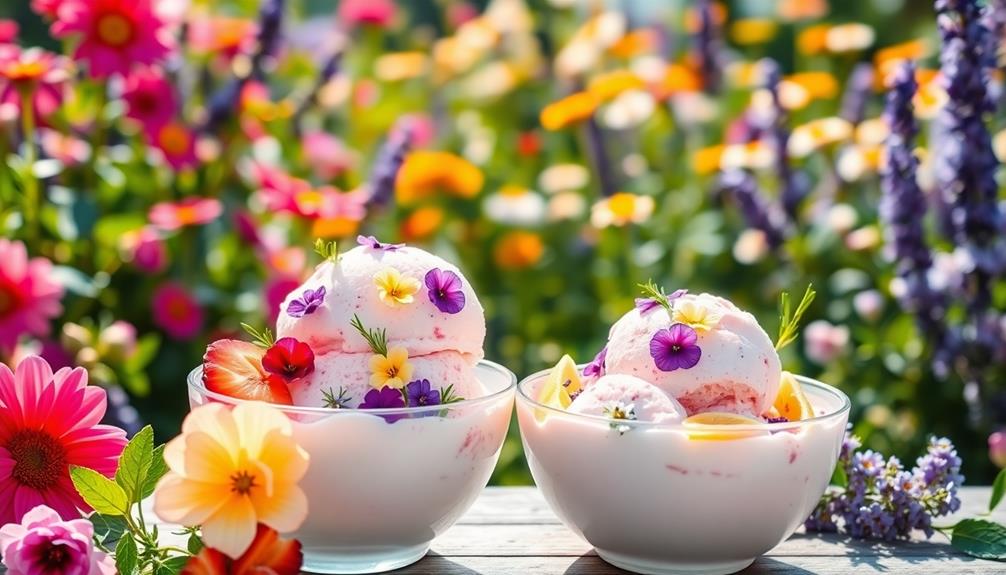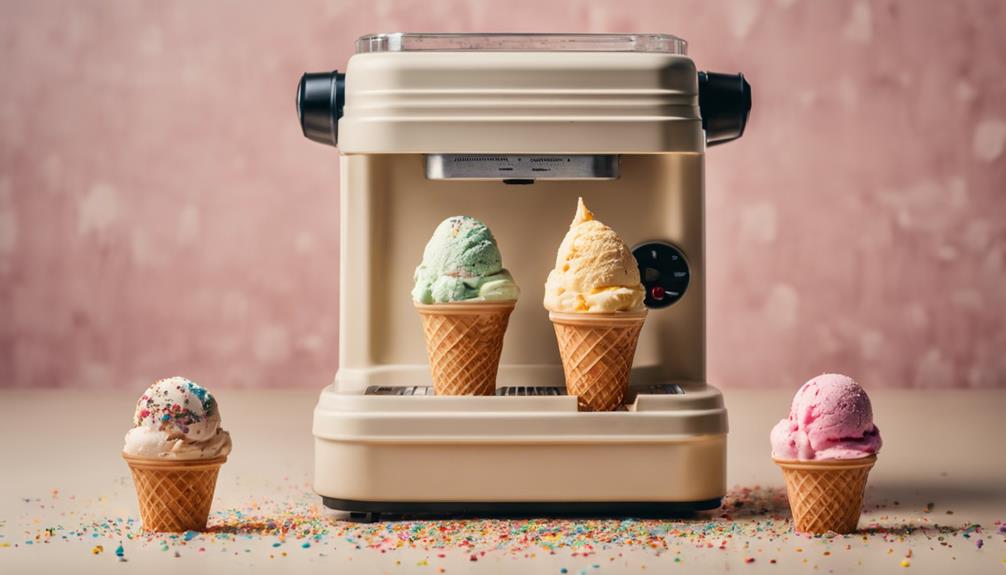To create the perfect ice cream base, you need to balance several key ingredients. Aim for 10-16% fat for creaminess and 12-16% sugar to enhance sweetness and texture. Incorporate nonfat milk solids to improve body and use emulsifiers like egg yolks to stabilize the mixture. Aging your base for 4-24 hours helps develop flavors and reduces ice crystal formation. Quick freezing techniques can further improve texture by minimizing ice crystals. With these elements in mind, you'll be on your way to a delightful homemade treat, and there's much more to uncover about making it truly exceptional.
Key Takeaways
- The ideal ice cream base composition includes 60% water, 15% sugar, 10% non-fat milk solids, and 10-20% fat for optimal texture and flavor.
- Sugar concentration between 12% and 16% lowers the freezing point and stabilizes the structure, resulting in smoother ice cream.
- Maintaining a fat content of 10-16% enhances creaminess and richness, while emulsifiers prevent fat clustering and improve texture.
- Proper aging of the mixture for 4-24 hours allows better emulsification and reduces ice crystal formation, improving overall stability.
- Rapid freezing techniques and maintaining ideal freezer temperatures (-23°C to -29°C) are crucial for minimizing ice crystal growth and achieving a smooth texture.
Understanding Ice Cream Chemistry
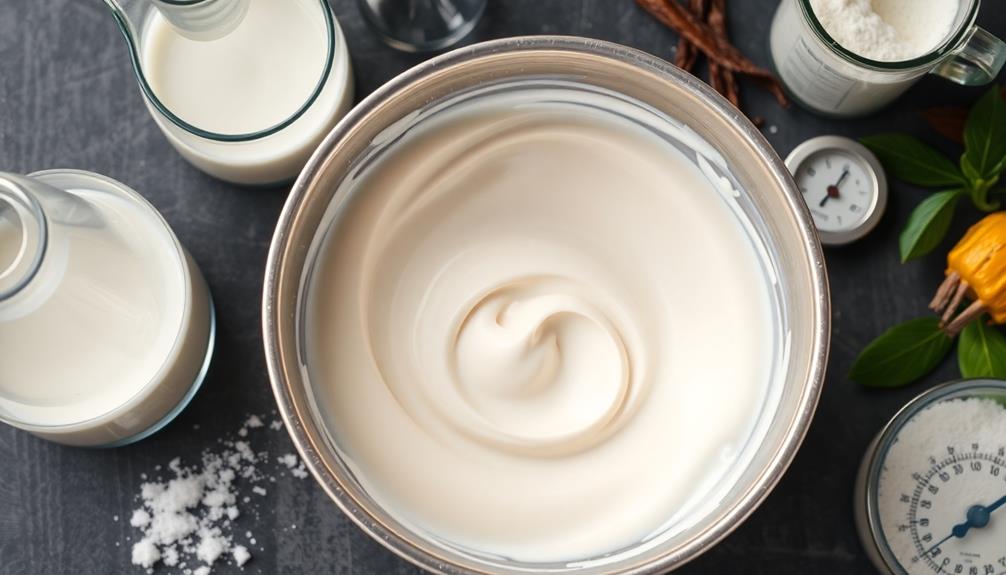
When you're crafting the perfect ice cream base, understanding the chemistry behind it's fundamental.
The ideal ice cream base typically contains about 60% water, 15% sugar, 10% non-fat milk solids, and 10-20% fat. This balance is essential for achieving the desired texture and flavor. The size of ice crystals is critical; smaller crystals, ideally between 10 to 20 µm, yield a smooth texture, while larger ones lead to a coarse mouthfeel.
Incorporating air during the freezing process, known as overrun, is another important factor. Premium ice creams usually have lower overrun (around 25%), resulting in a denser product, whereas cheaper options can reach up to 100%.
Emulsifiers, like egg yolks or commercial varieties, stabilize the mix, preventing fat globules from clumping together, which guarantees a creamy consistency.
Key Ingredients for Quality Base
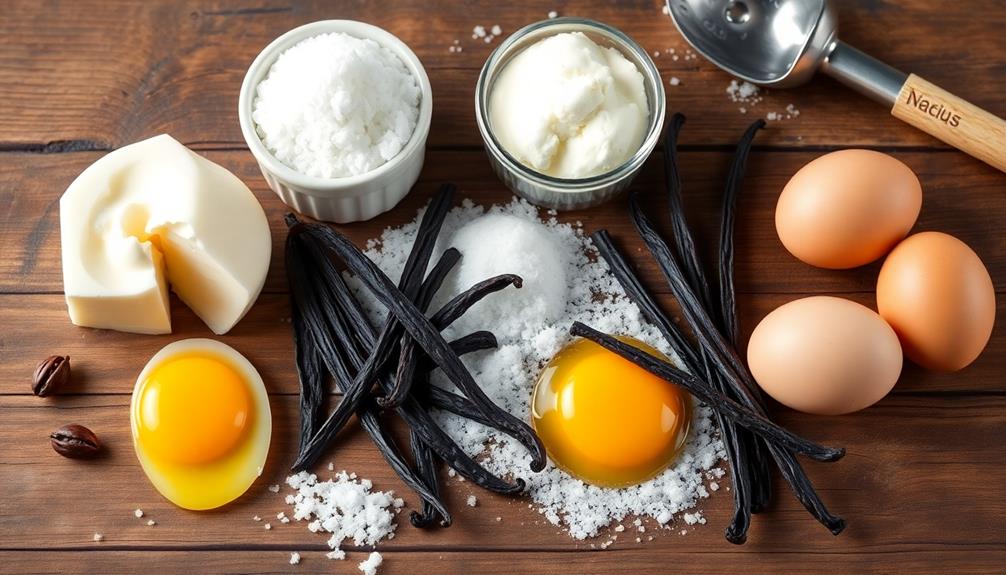
To create a quality ice cream base, you need to focus on the essential components: fat, sugar, and milk solids.
The right balance guarantees a smooth texture and rich flavor, while sugar not only sweetens but also helps prevent ice crystal formation.
Understanding these key ingredients is vital for achieving that perfect scoop.
Essential Base Components
Crafting a quality ice cream base hinges on the right balance of key ingredients that work together to create a delightful texture and flavor.
Start with the milk fat, aiming for about 10-16%. This fat content enhances creaminess, providing that luxurious mouthfeel you crave.
Next, include 9-12% nonfat milk solids, which contribute to the overall body and texture of your ice cream.
Sweeteners are essential too, making up 12-16% of your base. They not only add sweetness but also lower the freezing point, ensuring your ice cream remains scoopable.
For a smoother consistency, consider adding egg yolk solids at levels of 0-2%; they help with emulsification and enhance creaminess.
To maintain a consistent structure, incorporate stabilizers and emulsifiers at 0-1%. These ingredients prevent the formation of ice crystals, which can ruin the texture of your ice cream.
Role of Sugar
Sugar plays a vital role in crafting a high-quality ice cream base, influencing both flavor and texture. It doesn't just add sweetness; it also lowers the freezing point of your ice cream mix, preventing it from becoming a solid block. This guarantees you achieve that desirable creamy texture.
When you blend different types of sugar, like sucrose and glucose, you can enhance not only the sweetness but also the mouthfeel of your final product.
The ideal sugar concentration in your ice cream should typically range from 12% to 16%. This balance is essential for both sweetness and the freezing point depression necessary for a smooth consistency.
Sugar also stabilizes the ice cream structure by suspending ice crystals and air bubbles, contributing to the creaminess and scoopability you want.
Moreover, the presence of sugars in the ice cream mix affects the formation and size of ice crystals during freezing. Higher sugar concentrations lead to smaller ice crystals, resulting in a smoother mouthfeel.
Importance of Fat
When it comes to creating the perfect ice cream base, fat is a key player that can't be overlooked. The ideal fat content typically ranges from 10% to 16%. Higher fat levels yield a creamier texture and a richer flavor profile. Milk fat acts as a stabilizer, trapping air bubbles and enhancing the overall mouthfeel, resulting in a smooth and luxurious consistency.
Balancing fat is essential. Too much fat can lead to a gritty texture, while too little can create a coarse and icy mouthfeel. A combination of cream and milk helps regulate fat content: cream adds richness, while milk contributes to a lighter texture. This harmony is important for a quality ice cream base.
Using emulsifiers, such as egg yolks or commercial options like Polysorbate 80, guarantees proper dispersion of fat. These emulsifiers help prevent fat globules from clustering, which is crucial for achieving that coveted smooth and stable ice cream.
The Importance of Emulsifiers

When you're making ice cream, understanding emulsifiers is key to achieving the perfect texture and stability.
Whether you use egg yolks or commercial options like polysorbate 80, these ingredients play a vital role in keeping your mix smooth and creamy.
Let's explore the types of emulsifiers and how they benefit your ice cream's texture and overall stability.
Emulsifier Types Explained
The magic of emulsifiers lies in their ability to create a silky-smooth texture in ice cream, making them an essential component of any great recipe. They stabilize the dispersion of fat globules, preventing coalescence and ensuring a creamy mouthfeel.
Here are three common emulsifiers you might consider:
- Egg Yolks: Naturally rich in lecithin, egg yolks improve air incorporation and enhance the overall viscosity, resulting in a rich texture.
- Monoglycerides: These synthetic emulsifiers help stabilize the mix in commercial ice cream, allowing for longer shelf life and preventing larger fat globules from forming.
- Polysorbate 80: This versatile emulsifier aids in blending water, fat, and air effectively, ensuring that your ice cream maintains its structure and smooth texture.
Using emulsifiers at an ideal concentration of 0.1% to 0.5% is vital for balancing texture and stability.
Without them, your ice cream may develop a coarser texture and melt too quickly. Incorporating emulsifiers not only enhances the quality of your ice cream but also improves its overall enjoyment.
Benefits for Texture
Emulsifiers play an essential role in achieving the smooth, creamy texture that makes ice cream so delightful. They work by stabilizing the mixture, preventing fat particles from clustering together. This guarantees a uniform texture, which is vital for your ice cream experience.
When you incorporate emulsifiers like egg yolk or Polysorbate 80, you create a fine emulsion that effectively traps air, contributing to that rich, creamy consistency you love.
In your formulation, you'll typically include emulsifiers at levels ranging from 0-1%. This balance allows you to harness their benefits without compromising quality.
Without emulsifiers, your ice cream may develop a coarse texture, resulting in larger ice crystals that detract from mouthfeel and lead to faster melting.
Role in Stability
Achieving a smooth and creamy texture in ice cream isn't just about how it feels on your palate; it's also about stability. Emulsifiers play an essential role in this process by blending fat and water, preventing separation, and ensuring a consistent texture throughout your ice cream.
Here's why they matter:
- Improved Texture: Emulsifiers reduce surface tension between fat globules and water, enhancing the overall mouthfeel.
- Air Incorporation: They facilitate better air incorporation during churning, contributing to a creamier texture and minimizing large ice crystals.
- Extended Shelf Life: By stabilizing the ice cream mix, emulsifiers help maintain texture and prevent ice crystal growth during storage.
The ideal level of emulsifiers in your ice cream formulation usually ranges from 0 to 1%. Too much can lead to a gummy texture that detracts from the desired sensory qualities.
In short, the right emulsifiers not only enhance the overall stability of your ice cream but also preserve its quality, ensuring that each scoop is as enjoyable as the last.
Freezing Techniques and Equipment
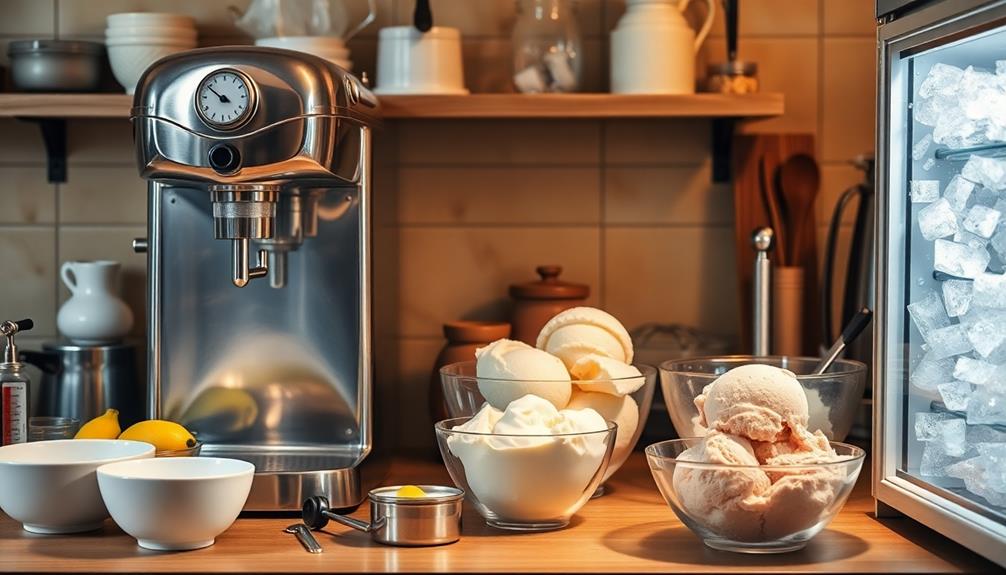
When creating ice cream, effective freezing techniques and the right equipment play an important role in determining the final product's quality. To achieve that creamy texture you desire, focus on maintaining ideal temperatures during ice cream production. The ideal freezer wall temperature for nucleation ranges from -23°C to -29°C (-9.4°F to -20.2°F). This helps promote smaller ice crystals, enhancing smoothness.
Proper equipment preparation is essential. Pre-chilling the freezer bowl to -30°C (-22°F) prevents water vapor buildup, which can lead to bacterial growth. Effective heat removal from the ice cream mix is critical; cooler bowl temperatures enhance nucleation rates and facilitate the formation of fine ice crystals.
For an even quicker method, consider rapid freezing techniques like using liquid nitrogen, which can freeze your ice cream base in seconds. Lower draw temperatures between -9°C to -12°C (15.8°F to 10.4°F) also contribute to smaller ice crystals.
Aging and Texture Development

Aging is an essential step in creating ice cream that boasts a rich texture and enhanced flavor. By allowing your ice cream mix to age for 4-24 hours, ideally overnight, you promote better emulsion and stability. This process is crucial for reducing ice crystals and achieving a creamy mouthfeel.
Here's why you should prioritize aging:
- Texture Improvement: Aging enhances the ability of milk proteins to hold water, reducing ice crystal formation during the freezing process.
- Air Bubble Retention: As emulsifiers displace proteins during aging, they help trap air bubbles, resulting in a smoother and creamier texture.
- Flavor Development: Aging at around 5 degrees Celsius optimizes flavor without risking bacterial growth, allowing the fat molecules and flavors to settle.
Additionally, incorporating skimmed milk powder increases the milk solids-not-fat (MSNF) content, further stabilizing your ice cream structure.
Tips for Homemade Ice Cream
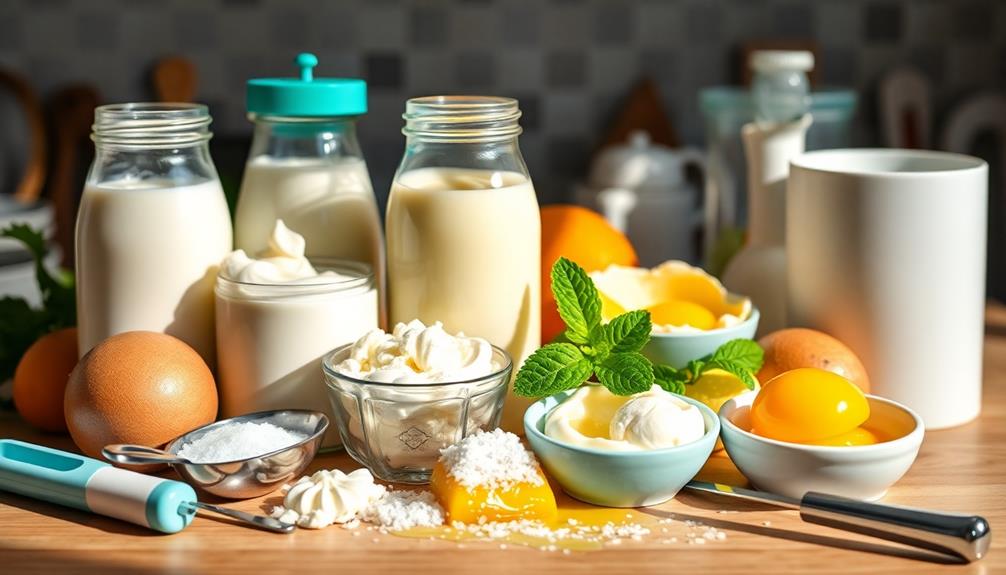
To create delicious homemade ice cream, you need a well-balanced base that combines the right proportions of fat, sugar, and nonfat milk solids. Start with approximately 10-20% fat, 12-16% sugar, and 9-12% nonfat milk solids for a creamy texture and proper freezing point depression.
Next, chill your ice cream base in an ice bath before refrigerating it for 4-24 hours. This enhances texture and minimizes bacterial growth during aging. Incorporate emulsifiers, like egg yolks or commercial options such as Polysorbate 80, to stabilize the mixture and prevent fat globules from clustering.
Using a high-quality ice cream maker is essential for churning at ideal temperatures of -20°F to -10°F. This helps in forming small ice crystals and enhances creaminess. Finally, monitor overrun, aiming for 20-50% air incorporation, to achieve the right balance between creaminess and density in your final product.
| Key Elements | Proportions/Details |
|---|---|
| Fat | 10-20% |
| Sugar | 12-16% |
| Nonfat Milk Solids | 9-12% |
| Chilling Method | Ice bath for 4-24 hours |
| Overrun | 20-50% air incorporation |
Frequently Asked Questions
What Is the Science Behind Ice Cream Making?
Ice cream making combines chemistry and technique. You balance ingredients like sugar, fat, and water, control temperature, and manipulate air incorporation. Understanding these factors helps you create a smooth, creamy texture that delights the palate.
What Is the Secret to Making Ice Cream Very Creamy?
To make ice cream really creamy, focus on using a higher fat content, balance your sugars, incorporate emulsifiers, and freeze rapidly. Letting your mixture age before churning also enhances the creaminess and flavor.
What Makes up the Base of Ice Cream?
The base of ice cream consists of milk, cream, sugar, and sometimes egg yolks. These ingredients blend to create a creamy texture, while sugar regulates freezing, ensuring your ice cream's smooth and delicious.
What Is the Ice Cream Theory?
The ice cream theory focuses on balancing fat, sugar, and water to create a smooth texture. You'll learn that controlling ice crystal size and incorporating air is essential for achieving the perfect ice cream consistency.
Conclusion
In the delightful dance of ice cream creation, every ingredient plays a crucial role, harmonizing to create the perfect symphony of flavor and texture. By understanding the chemistry behind your base and employing the right techniques, you're not just making ice cream; you're crafting a frozen masterpiece. So, grab your whisk and embrace the magic of homemade ice cream. With each scoop, you'll savor the sweet rewards of your culinary adventure, turning simple moments into creamy bliss.


